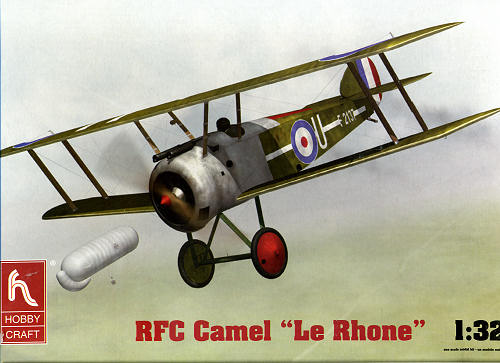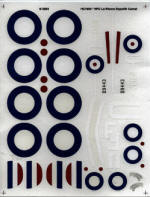
Hobbycraft 1/32 Sopwith Camel 'Le Rhone'
| KIT: | Hobbycraft 1/32 Sopwith Camel 'Le Rhone' |
| KIT #: | HC 1693 |
| PRICE: | $20.80 from GreatModels |
| DECALS: | Three options |
| REVIEWER: | Scott Van Aken |
| NOTES: |

| HISTORY |
Intended as a replacement for the Sopwith Pup, the Camel prototype first flew in December 1916, powered by a 110 hp Clerget 9Z. Known as the "Big Pup" early on in its development, the aircraft was armed with two .303 in (7.7 mm) Vickers machine guns mounted in the cowl, firing forward through the propeller disc. A fairing surrounding the gun installation created a hump that led to the name Camel. The top wing was flat - but the bottom wing had dihedral, so that the gap between the wings was less at the tips than at the roots. Approximately 5,490 were ultimately produced.
The type entered squadron service in June 1917 with No. 4 Squadron of the Royal Naval Air Service, near Dunkirk. The following month, it became operational with No. 70 Squadron of the Royal Flying Corps. By February 1918, 13 squadrons were fully equipped with the Camel.
Unlike the preceding Pup and Triplane, the Camel was not considered pleasant to fly. The Camel owed its difficult handling characteristics to the grouping of the engine, pilot, guns, and fuel tank within the first seven feet of the aircraft, coupled with the strong gyroscopic effect of the rotary engine.
The Camel soon gained an unfortunate reputation with student pilots. The Clerget engine was particularly sensitive to fuel mixture control, and incorrect settings often caused the engine to choke and cut out during takeoff. Many crashed due to mishandling on takeoff when a full fuel tank affected the center of gravity. In level flight, the Camel was markedly tail-heavy. Unlike the Triplane, the Camel lacked a variable incidence tailplane. The pilot was therefore required to apply constant forward pressure on the control stick to maintain a level attitude at low altitude. However the machine could also be rigged in such a way that at higher altitudes it could be flown "hands off." A stall immediately resulted in a spin and the Camel was particularly noted for its vicious spinning characteristics.
The Camel was, however, a superlative fighter. In the hands of an experienced pilot, its instability became manoeuvrability. The aircraft offered heavier armament and better performance than the Pup and Triplane. Its controls were light and sensitive. The Camel turned slowly to the left which resulted in a nose up attitude due to the torque of the rotary engine, but turned very sharply to the right which resulted in a nose down attitude. Because it was tail heavy, the plane also looped quickly. Agility in combat made the Camel one of the best remembered Allied aircraft of the First World War. It was said to offer a choice between a "wooden cross, red cross and Victoria Cross." Together with the S.E.5a, the Camel helped to wrest aerial superiority away from the German Albatros scouts. The Camel was credited with shooting down 1,294 enemy aircraft, more than any other Allied scout.
Major William Barker's Sopwith Camel (serial no. B6313, the aircraft in which all his victories were scored,) became the most successful fighter aircraft in the history of the RAF, shooting down 46 aircraft and balloons from September 1917 to September 1918 in 404 operational hours flying. It was dismantled in October 1918. Barker kept the clock as a memento, although he was asked to return it the following day.
By mid-1918, the Camel was approaching obsolescence as a fighter, limited by its slow speed and comparatively poor performance over 12,000 feet (3650 m). It found a new lease of life as a ground-attack aircraft and infantry support weapon. During the German Offensive of March 1918, flights of Camels harassed the advancing German Army, inflicting high losses (and suffering high losses in turn) through the dropping of 25lb (11 kg) Cooper bombs and ultra-low-level strafing. The protracted development of the Camel's replacement, the Sopwith Snipe, meant that the Camel remained in service until the Armistice.
In summer 1918, a 2F.1 Camel (N6814) was used in trials as a parasite fighter under Airship R23.
Production Camels used a variety of different engines, as listed below.
As an additional note on rotary engines. Rotary engines did not have throttles and were at full 'throttle' all the while the ignition was on. The engine had to be "blipped" (turned off and on) using a control column-mounted ignition switch, (blip switch) to reduce power sufficiently for a safe landing.
| THE KIT |
 The Hobbycraft kit of the Camel has been around for a bit. Like all WWI aircraft, it seems that 1/32 provides what many consider to be the best scale as it allows for ease of rigging and detailing; yet still takes up little shelf space.
The Hobbycraft kit of the Camel has been around for a bit. Like all WWI aircraft, it seems that 1/32 provides what many consider to be the best scale as it allows for ease of rigging and detailing; yet still takes up little shelf space.
The molding on this kit is quite good. Fabric areas are quite taut and really, quite flat as well. There are raised areas on all the flight surfaces that are probably meant to represent rib tapes. Many will consider this to be overdone, but can be easily remedied with some sandpaper or a sanding stick of one doesn't like it. One piece upper and lower wings means ease of construction and the correct lower wing dihedral. As most of the forward fuselage was wood, Hobbycraft offer wooden cut-out sections in the instruction sheet to duplicate the wooden face of the instrument panel, interior side walls and the seat sections, a rather interesting way to take care of this situation. Or one could use various aftermarket 'wood' decals and photo-etch seats. The kit is simple as you'd expect from a WWI aircraft and provides the basics that include nicely done guns and a engine.
Instructions provide the aforementioned wooden cut-outs and color info in Polly Scale, Humbrol and Model Master references. There are various notes when a modification may be needed and two full pages are used to assist in rigging, an important part of these aircraft. All of the exterior color and markings information is provided on the back of the box. All have PC 10 (khaki drab) upper surfaces and two of the three have bleached linen for the undersides of wings and tail planes.
and markings information is provided on the back of the box. All have PC 10 (khaki drab) upper surfaces and two of the three have bleached linen for the undersides of wings and tail planes.

The three markings options are for a 80 squadron night fighter in August 1918 with black undersides and forward fuselage. It also has the white omitted from the rudder stripes. Next is a 48 squadron plane from October 1918 flown by Donald MacLaren. Finally, a 3 squadron plane from August 1918 as flown by A.T. Partridge. The decals are very well printed and being the 'newer' Hobbycraft decals should be as good as any aftermarket. It is printed on a white background which means I had to seriously darken the scan so you could see the white markings.
| CONCLUSIONS |
As of this writing, this is the best 1/32 Camel around. It is inexpensive and appears to be pretty easy to build from what I've seen and heard. If you are considering getting into WWI aircraft or want to expand your rigging abilities, I can think of no better kit with which to start.
| REFERENCES |
http://en.wikipedia.org July 2008 You can get this and many other superb kits and accessories at www.greatmodels.com . If you would like your product reviewed fairly and fairly quickly, please contact the editor or see other details in the